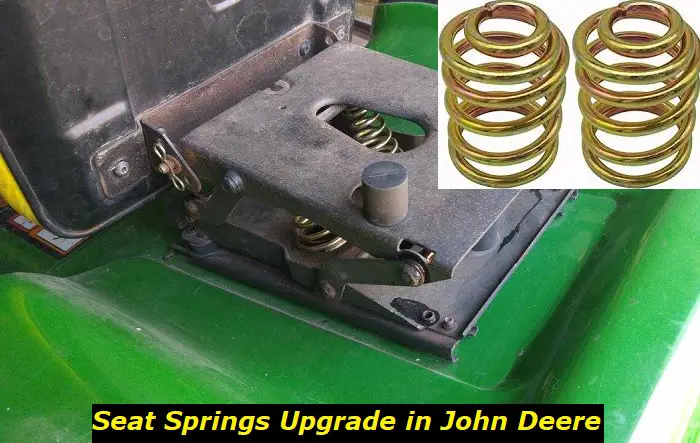John Deere Seat Spring Upgrade: Enhancing Machinery Performance
For operators and owners of John Deere machinery, a common yet often overlooked area of improvement is the seat spring. These seemingly insignificant components play a crucial role in boosting both comfort and efficiency, ultimately having a direct impact on machinery performance. By enhancing operator comfort to reduce fatigue, a seat spring upgrade can noticeably improve productivity and machine handling.
However, the issues associated with original seat springs in John Deere machinery are all too common. From decreased comfort due to wear and tear, to ineffective shock absorption causing increased fatigue, these problems can significantly affect performance. Understanding this, the article delves into common seat spring issues, their effects on efficiency, and most importantly, how an upgrade can address and overcome these challenges.

Understanding Seat Spring Issues in John Deere Machinery
In the world of heavy machinery, a notable name is John Deere. With its rich heritage and continuous commitment to delivering quality, it's no wonder many operators and owners unquestionably entrust their daily operations to John Deere machinery. However, just like any equipment, it's not immune to issues and one of these concerns can be the seat springs.
Now, you might wonder, how can something as simple like seat springs raise issues in such robust machinery? From the surface, this component might seem minor, but delving deeper, we find that these springs actually hold a significant influence over the operator's comfort and overall machinery efficiency.
The seat spring, which serves as the backbone of the seat suspension system, endures consistent weight and movement. Over time, the consistent stress can lead to wear and tear. This would result in the seat becoming less resilient and losing its ability to effectively absorb shocks, promoting a harsher ride. This can become increasingly discomforting for the operator, leading to an impact on overall operational efficiency. A deteriorating seat spring can make long working hours tiresome, affecting the operator's alertness and productivity.
Another commonly reported problem with the original seat springs in John Deere machinery, particularly in older models, is their rigidity. The lack of give or flexibility in these seat springs often translates into a hard and uncomfortable sitting experience for the operator. This again, culminates in decreased efficiency due to growing discomfort over prolonged periods of use.
Seemingly small, these issues substantiate over time and can significantly affect the operator's experience and the overall performance of the machinery. Therefore, understanding and addressing seat spring issues promptly is essential for maintaining operator comfort and ensuring efficient operations.
The Role of Seat Springs in Machinery Comfort and Performance
When operating heavy machinery like John Deere tractors or loaders, you might not realize just how much of a role the humble seat spring plays in your overall experience. But make no mistake, the seat spring is an unsung hero when it comes to machinery comfort and performance.
Think about it - as an operator, you spend long hours seated at the helm of these powerful machines. The pressure and vibrations from the machine transmit directly to you, the operator. It's the job of the seat spring to absorb and reduce this pressure, ensuring that you're not feeling every jolt and judder from the machine. This smoothness contributes significantly to the levels of comfort you experience.
But what happens when these springs wear out or fail? The result is increased discomfort and fatigue. Your body has to bear the brunt of those shocks and vibrations that the worn-out springs fail to dampen. This isn't just about comfort; it could also mean potential health issues such as back pain or stiffness. A good quality, upgraded seat spring promotes better posture and reduces the physical stress on your body.
And here's where performance comes into the picture. When you, as an operator, are comfortable and free from fatigue, you can focus better on navigating and controlling your machinery. This inevitably leads to increased productivity and efficiency. A well-maintained seat spring is the key to unlocking this enhanced performance. So, while seat springs might seem like a small component of your John Deere machine, their role in ensuring operator comfort and health, and hence the machine's overall performance, cannot be overstated.
Step-by-step Guide to John Deere Seat Spring Upgrade
Initiating a John Deere seat spring upgrade may seem like a daunting task at first, but be assured, armed with the right tools and instructions, even the unseasoned operator can successfully complete this upgrade. Let's guide you through this process so you can enjoy a new level of comfort and productivity.
First things first, you need to ensure you have the correct replacement springs at hand. High-quality, brand-specific components are recommended to ensure compatibility and optimal performance. A John Deere genuine part or a credible after-market part will deliver on these fronts.
After receiving your new seat springs, start by turning off your John Deere machine and securing the parking brake. Safety is paramount, so don't skip this crucial step. Then, you can proceed to disassemble the existing seat assembly to gain access to the old springs.
This is usually achieved by removing a series of bolts and pivot pins that hold the seat pan, suspension, and existing springs in place. While the specific location and number of these might vary depending on the exact model of your John Deere machine, they are generally fairly easy to spot.
Next, you will carefully remove the old springs, making certain to note the position and orientation of each one. This will be useful when installing the new springs. Use an appropriate tool, such as a pair of tong-like grip pliers to compress and then safely remove the seat springs.
Now, you're ready to install your new seat springs. Ensure you match each spring to its corresponding position, just as they were in the old setup. Carefully compress each new spring using the grip pliers, set it in place, and then slowly release the pliers. Verify that each spring supports the seat assembly as it supposed to do and is properly aligned.
Once the new springs are in place, you can reassemble the seat. This will involve reconnecting the seat pan, suspensions, and other components you had earlier removed. Ensure each bolt and pivot pin is firmly secured to shield your new springs and seat assembly from premature wear and damage.
Finally, check the seat's overall function. Sit on it, bounce a little, move around. Make sure it feels right, more comfortable, and supportive. The noticeable bounce back is a testament of newly installed and high-functioning seat springs.
Remember, the primary objective here is enhancing comfort for improved productivity. So, don't underestimate the importance of this seemingly simple procedure. Every step taken towards the enhancement of operator comfort is a step towards optimized performance and productivity.
Key Elements to Consider when Upgrading Seat Springs
If you're planning to improve your machinery comfort with a John Deere seat spring upgrade, there are certain factors to keep in mind in order to make the best decision. It's more than just buying a new piece; it's about investing in an enhancement that will impact your machinery's productivity and your comfort.
Firstly, a very important consideration is the material of the seat spring. It should be durable and resistant to daily wear and tear. You wouldn't want to invest in a component that will necessitate replacements frequently. Stainless steel and chrome silicon are commonly used as they provide remarkable resilience and longevity.
Next, take into account the compatibility of the seat spring. Different models of John Deere machinery may require varying types of springs, so make sure the one you choose fits your specific model. Wrong specification can lead to improper fitting and ultimately, inefficient performance.
The installation process is another element to ponder over. Some seat springs are easier to install than others, which can be a deciding factor if you're doing it by yourself. Choosing a spring that comes with a comprehensive guide can make the upgrade process significantly smoother.
Last but not least, cost-efficiency does matter. It's not only about the initial cost of acquiring the spring, but also the long-term benefits it brings by improving efficiency and reducing replacement needs. The right investment today will pay off in the long run, by offering comfort and maintaining consistency in performance.
Remember, an effective John Deere seat spring upgrade is not simply a quick fix, but a thoughtful enhance to your machinery's overall performance and your comfort.
The Impact of Seat Spring Upgrades on John Deere Machinery Performance
As any seasoned mechanic in heavy machinery can attest, the most meticulous maintenance routines and highest quality machinery can still fall short if operator comfort is ignored. In fact, the humble seat spring upgrade, often underestimated, can have a profound impact on the overall performance of your John Deere machine.
This nuance lies in one simple truth - an operator who is comfortable can achieve remarkable productivity boosts and efficiencies. By reducing operator fatigue and discomfort linked to long hours of machinery operation, a well-upgraded seat spring contributes significantly to the individual's ability to focus on the task at hand. This, in turn, enhances the overall handling of the machine and ultimately, the quality and quantity of work that gets done.
It's worth noting too, that the impact of such an upgrade extends far beyond just the operator's wellbeing. Effectively, a good seat spring can minimize jolts and vibrations, thereby reducing the potential wear and tear on the other parts of the machine. This can lead to longer machinery life and lower maintenance costs over time.
A John Deere seat spring upgrade is not just about replacing a worn-out part. It is an investment in machine performance, operator comfort and sustained productivity. Indeed, a seat spring upgrade could be one of the most cost-effective improvements you can make to your heavy machinery. The benefits, both immediate and long-term, are many and clear to see, provided you take the time to appreciate the critical role this small, unassuming component plays in the larger scheme of things.

Add comment